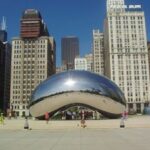Edward Gorey was an exceptional illustrator who was peerless, defied classification and has been described simultaneously as both an artist who wrote and a writer who drew. He has a cult of devotees in the millions and is known for his macabre and Victorian, Gothic crosshatch illustrations.
Edward St. John Gorey was born on February 25, 1925 in Chicago to parents Helen Dunham Garvey and Edward Lee Gorey. Gorey’s childhood was nothing if not interesting as his parents divorced when he was 11 years of age, but then remarried again when he was 27.
Gorey has claimed to have inherited his illustrating and writing talents from his maternal great-grandmother, a 19th century greeting card artist, who went by the name of Helen St. John Garvey. Edward Gorey’s first drawings as a one and a half year old child were of passing trains, but he has said that they were highly unimpressive and looked like irregular sausages and insists that he showed no talent whatsoever. He was also an avid reader, and finished Bram Stoker’s Dracula at the age of 5.
While Edward Gorey had no formal art training, he did spend one semester at The Art Institute of Chicago in 1943. After attending the Art Institute of Chicago, Gorey spent the years 1944 to 1946 serving in the U.S. Army as a clerk for Dugway Proving Ground in Utah. Dugway Proving Ground was a place where poison gas and mortars were tested.
By the age of 20, Edward Gorey was studying as a French Literature major at Harvard where he was befriended by future poet Frank O’Hara. A fellow student at Harvard remembers Gorey as “the oddest person I’ve ever seen. He was very tall, with his hair plastered down across the front like bangs, like a Roman emperor.”
O’Hara and Gorey were Harvard’s very own dandies as they flounced about the campus pretending that they were both Oscar Wilde. They read books by Ronald Firbank, spent much time in used bookstores and decorated their campus apartment with modern white furniture which included not only a chaise lounge, but also a coffee table that was built from a tombstone taken from a local cemetery.
Once Edward Gorey received his degree from Harvard in 1950, he worked in publishing as a book-jacket illustrator at Doubleday’s art department for 8 years. His list of illustrated works for others is quite versatile as he did work for T.S. Eliot’s Old Possum’s Book of Practical Cats, Bram Stoker’s Dracula and H.G. Wells’ The War of the Worlds.
He was briefly interested in running his own bookstore, but after working in one changed his mind. Gorey also felt that becoming a librarian would be an interesting line of work, until he says that he met some crazy ones and changed his mind about that also.
One thing that Edward Gorey was decidedly fond of was ballet. He spent 30 years attending very nearly every performance by the New York City Ballet, and called the Russian choreographer Balanchine a god.
After being turned down repeatedly by publishers, Gorey finally had some luck when The Unstrung Harp was published in 1953. One of the things that Gorey was very fond of doing was publishing books under various pen names which were all anagrams. Ogdred Weary was one of them as was Mrs. Regera Dowdy, Dogear Wryde, Wardore Edgy, E. G. Deadworry and D. Awdrey-Gore.
More than a few publishers were confused when they saw Edward Gorey’s work at first glance since many of his illustrations were of children. They mistakenly felt that he was an illustrator of children’s books, which couldn’t have been further from the truth.
This is evidenced by one of his best-loved books, The Gashlycrumb Tinies which was published in 1963. This is an alphabet book with a difference. Each letter of the alphabet relates to a child’s name and this book of black and white illustrations deals with death in a humorously macabre and gothic way. The alphabet book tells the story of 26 children and their demises. Thus the first two pages of The Gashlycrumb Tinies: “A is for Amy who fell down the stairs,” which depicts Amy falling from the great heights of a dark, Victorian stairway and “B is for Basil, assaulted by bears,” shows two ominous looking bears who look as though they find Basil to be a very delicious meal.
In 1959, the literary critic Edmund Wilson wrote in glowing terms of Edward Gorey, calling him “poetic and poisoned,” and compared him to Max Ernest and Ronald Searle.
Because of the style of Edward Gorey’s work, many of his fans mistakenly thought that he was British. In fact, he never once visited England during his life and lived in Cape Code, Massachusetts, where he was surrounded by the cats that he so loved.
Gorey not only wrote books and illustrated, but he also wrote and directed theatrical works and worked on PBS’s Mystery series, amongst other things. He has had a strong legion of fans throughout the years that have included people as diverse as Trent Reznor of Nine Inch Nails. Trent Reznor enlisted Gorey to help work on his video for The Perfect Drug.
Edward Gorey died in April of 2000, but anyone that is interested in his works should look into the 4 omnibus editions of his collections as they piece together work over different eras and this is much easier than hunting down all of his separate books. Amphigorey and Amphigorey Too are a marvelous place to start for anyone interested in investigating Edward Gorey.
Sources: Wikipedia, archive.salon.com/people/bc/2000/02/15/gorey/index2.html, www.pbs.org/wgbh/mystery/gorey.html




